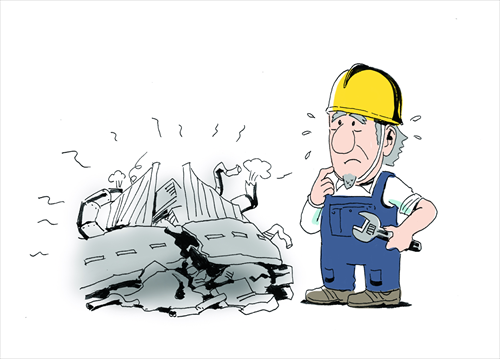HOME >> OP-ED
Crumbling infrastructure belies US power
By Charles Gray Source:Global Times Published: 2015-5-27 22:23:01

Illustration: Liu Rui/GT
From decaying roads and bridges to airports that are, in the words of US Vice President Joseph Biden, comparable to "some third-world country," US infrastructure is increasingly decrepit. Despite the country's economic might, the American Society of Civil Engineers (ASCE) rated US overall infrastructure with a D+ grade in 2013 and estimated that about $3.6 trillion would be needed in order to effectively update and expand the nation's infrastructure by 2020.
The challenge facing the country is a daunting one. Roads, sewage treatment systems, water networks, dams and electrical grids have all faced increasing demand in the face of an ever-growing population, while infrastructure funding has plunged to historic lows. In part, these declines were due to the 2008 recession, when state and local governments struggled with massive funding shortfalls. However, even before the recession, many experts were sounding the alarm over decaying infrastructure.
Today, the US spends under 2 percent of its annual GDP on infrastructure compared to 5 percent in Europe and 9 percent in China. While other nations roar ahead, the American people find their own government unable to maintain its position in the face of this growing infrastructure deficit.
In many cases, this decaying infrastructure can produce a serious danger to public safety. For example, the ASCE has claimed that in 2013 there were 2,000 dams that were considered deficient and potentially posed a serious threat to local populations if they failed. Similarly, improperly maintained roads and bridges can pose an immediate threat to the individuals using them.
In some cases, rural agencies have made the dramatic decision to strip the asphalt from their roads in favor of gravel surfaces, leaving them with roads little different from those that graced the nation before the rise of the automobile. In fact, it is possible that the recent Amtrak accident was due to the organization's chronic underfunding. Experts have cited the lack of a "positive train control" system that might have prevented the derailment.
Additionally, the potential damage to US long-term economic prosperity produced by a failing national infrastructure is an extremely serious issue. Anyone who has endured an interminable delay in a traffic jam can attest to the lost productivity created by infrastructure failings. Businesses can face lost productivity due to power or water failures, as well as the potential for costly shipping delays due to overcrowded roads, ports and airports. At worst, such problems could convince a business that it might be wiser to relocate rather than continue to endure ever-worsening conditions.
Unfortunately, solving this issue is more easily said than done. In addition to funding issues, responsibility for maintaining and expanding US infrastructure is often handled by a confusing mixture of local, state and federal authorities. Especially in an era of tight budgets, a jurisdiction may find itself having to choose between deferring maintenance to existing infrastructure and adding new infrastructure improvements to keep up with the region's population growth.
Monetarily, the congress continues to refuse to raise the gasoline tax, which has required a number of short-term funding solutions in order to ensure that the Highway Trust Fund does not go broke even at its current inadequate spending levels. Yet it's true that raising the gas tax would be unpopular among many Americans, especially those who have yet to fully recover from the recent recession and face long daily commutes. Other tax increases or funding methods have also been stymied by opposition from a variety of groups.
How can the US rebuild its infrastructure? Perhaps the first step is in recognizing that nothing comes for free. The need to maintain current infrastructure while adding new dams, roads, electrical grids and sewage systems will require increased funding levels. In this case, America's traditional dislike of taxes should be counteracted by the fact that investing in the nation's infrastructure can pay dividends for decades to come. Ultimately, a nation with a decaying infrastructure is a nation that cannot remain competitive. The US must accept that maintaining an adequate national infrastructure is a goal that is well worth the added cost.
The author is a freelance writer based in Corona, California. charlesgray109@gmail.com
Posted in: Viewpoint